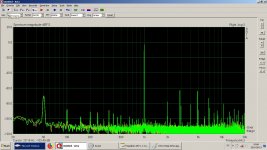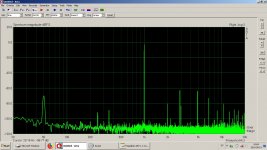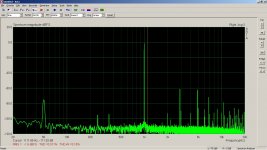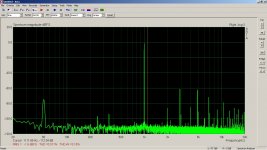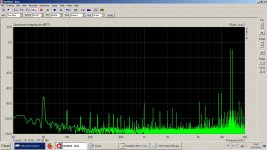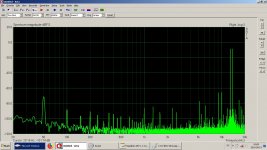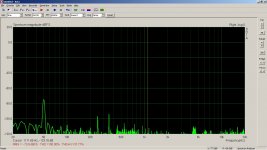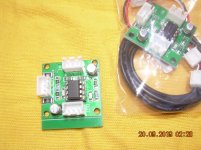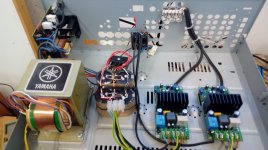Hello!
I bought a pair of the LJM L15 Pro boards, and connected them for the first time yesterday. Power supply is linear +-57V with 22mF/rail.
However, first impression of the sound was not that good, mids and highs a bit 'grainy', and also bass did not seem as 'dynamic and contolled' as I hoped for.
Speakers used for test are only basic workshop speakers at 8ohm. Maybe giving a small peak in top end response, but I doubt that explains the impression of the sound.
FFT confirmed that it has pretty high distortion (into 8ohm resistors) with a lot of high order spikes at normal listening levels 1-10W, and IMD pretty much the same, a lot worse than any solid state amp I measured. With 1kHz in, 2nd & 3rd harmonics were at abt -50 to -60dB, and higher harmonics not much lower.
I see a 'carrier' at about 1Vpp, and frequency around 500kHz (a little high?)
I scoped the supply voltage at the main PS caps and it seems nice and steady, as it should with such an easy load and low power output. I also tried 'reversing' one channel (inverted input and output polarity), and saw a small improvement in supply voltage stability, but could not hear any difference.
I'm planning to add a trimmer to be able to adjust the switching frequency, and have some thoughts on increasing the capacitance on the low voltage supplies (over the zeners). My local supplier does not have any caps (that fit) that I would consider an improvement for the main rails on the board.
Is this what is expected of the irs2092, or is it even worth it to try to tweak them? As I understand it, the LJM board are considered well made?
I bought a pair of the LJM L15 Pro boards, and connected them for the first time yesterday. Power supply is linear +-57V with 22mF/rail.
However, first impression of the sound was not that good, mids and highs a bit 'grainy', and also bass did not seem as 'dynamic and contolled' as I hoped for.
Speakers used for test are only basic workshop speakers at 8ohm. Maybe giving a small peak in top end response, but I doubt that explains the impression of the sound.
FFT confirmed that it has pretty high distortion (into 8ohm resistors) with a lot of high order spikes at normal listening levels 1-10W, and IMD pretty much the same, a lot worse than any solid state amp I measured. With 1kHz in, 2nd & 3rd harmonics were at abt -50 to -60dB, and higher harmonics not much lower.
I see a 'carrier' at about 1Vpp, and frequency around 500kHz (a little high?)
I scoped the supply voltage at the main PS caps and it seems nice and steady, as it should with such an easy load and low power output. I also tried 'reversing' one channel (inverted input and output polarity), and saw a small improvement in supply voltage stability, but could not hear any difference.
I'm planning to add a trimmer to be able to adjust the switching frequency, and have some thoughts on increasing the capacitance on the low voltage supplies (over the zeners). My local supplier does not have any caps (that fit) that I would consider an improvement for the main rails on the board.
Is this what is expected of the irs2092, or is it even worth it to try to tweak them? As I understand it, the LJM board are considered well made?
If that particular board is using the internal zeners for regulation and doesn't augment them with large 'lytics on the rails then, based on my experience, that sound description is pretty much par for the course. 500kHz is a bit high, the original appnote from IR suggests 400kHz at idle. Around 1V carrier is fairly typical too, 1V p-p seems better than average perhaps due to the higher than normal idle freq.
Distortion measurements LJM L15d-Pro
I took some distortion measurements and screenshots, so this is what I'm seeing, and possibly hearing?
See the filenames for details. The IMD measurements are taken with the same amplitude setting as the 20Vpp. I did not even bother to get a better sound card, since distortion is clearly visible even with the Behringer UCA222.
I tried adjusting the switching frequency with fft running, but saw absolutely no difference. Now it's around 400/425kHz per channel.
I took some distortion measurements and screenshots, so this is what I'm seeing, and possibly hearing?
See the filenames for details. The IMD measurements are taken with the same amplitude setting as the 20Vpp. I did not even bother to get a better sound card, since distortion is clearly visible even with the Behringer UCA222.
I tried adjusting the switching frequency with fft running, but saw absolutely no difference. Now it's around 400/425kHz per channel.
Attachments
Last edited:
The screenshots don`t look that bad. Usual 50Hz noise. Maybe you could post some pictures of installation, power supply etc.
I have recently reversed my opinion about "burn in voodoo". Maybe leave them alone at some low load like 5 watt or so, over night. I heard some very strange improvements after such a cure with D-amps recently. Do not ask me why.
as an alternative, if you can get them, replace the MOSfet´s by some from a trustworthy source.
Many of these amps fail during the first hours, because of blow´n FET´s. They may be fake or refurbished from the manufacturers garbage bin. "Second selection", maybe even worse. While doing so. look for shortcut at the heat sink , apply good pressure and use thermal compound.
Many amps profit from a simple buffer, NE5532 will do, not to have one might be a "no go", as many amp´s input stages are extremely simplified.
There are many small, cheap PCB´s at eBay, Ali etc. that can be soldered directly at the input RCA. Change the OP amp for a real NE5532, as these are usually fake.
The pictured one is inverting (no problem) and has gain of 10x (has to be changed to 1x) Less than 2 Euro, you do not make the PCB for that money.
I have recently reversed my opinion about "burn in voodoo". Maybe leave them alone at some low load like 5 watt or so, over night. I heard some very strange improvements after such a cure with D-amps recently. Do not ask me why.
as an alternative, if you can get them, replace the MOSfet´s by some from a trustworthy source.
Many of these amps fail during the first hours, because of blow´n FET´s. They may be fake or refurbished from the manufacturers garbage bin. "Second selection", maybe even worse. While doing so. look for shortcut at the heat sink , apply good pressure and use thermal compound.
Many amps profit from a simple buffer, NE5532 will do, not to have one might be a "no go", as many amp´s input stages are extremely simplified.
There are many small, cheap PCB´s at eBay, Ali etc. that can be soldered directly at the input RCA. Change the OP amp for a real NE5532, as these are usually fake.
The pictured one is inverting (no problem) and has gain of 10x (has to be changed to 1x) Less than 2 Euro, you do not make the PCB for that money.
Attachments
Last edited:
Ok, maybe I should leave them on and see what happens.. smoke or voodoo 
I'm not so keen on throwing more money at them with fet's etc, since I 'm not sure if I will even use them. I was thinking about buffers for input impedance, and to invert one channel in case I use them for woofers to prevent 'rail pumping'.
I don't worry about the 50Hz in the measurements, it's 'EMC problems' in my measurement setup/garage. However I'm not so impressed with all the spikes from harmonics in the measurements.
Hiss can be heard from tweeters, so gain should probably be lowered if I want to use them full range.
Will see if I remember to get a pic of the test setup.
I'm not so keen on throwing more money at them with fet's etc, since I 'm not sure if I will even use them. I was thinking about buffers for input impedance, and to invert one channel in case I use them for woofers to prevent 'rail pumping'.
I don't worry about the 50Hz in the measurements, it's 'EMC problems' in my measurement setup/garage. However I'm not so impressed with all the spikes from harmonics in the measurements.
Hiss can be heard from tweeters, so gain should probably be lowered if I want to use them full range.
Will see if I remember to get a pic of the test setup.
Last edited:
First I would like to 'cancel' my measurement results above! I redid the measurements with a better sound card, and now they look 'normal' and not so bad. Noise floor from the amp is a bit high though. I did not remember that the Behringer sound card was actually that bad for amp distortion measurements, I often use if for measuring speakers, and it's ok for that.
I also measured frequency response to 8 & 4 ohm. At 8ohm it's slightly peaking at 20kHz, and at 4ohm sligtly falling. Around 3dB differance between the two at 20kHz, no differance at 10kHz.
I put them to work heating resistors with music overnight, so I guess today I will see if there was smoke or magic
Picture of test setup attached as requested
I also measured frequency response to 8 & 4 ohm. At 8ohm it's slightly peaking at 20kHz, and at 4ohm sligtly falling. Around 3dB differance between the two at 20kHz, no differance at 10kHz.
I put them to work heating resistors with music overnight, so I guess today I will see if there was smoke or magic
Picture of test setup attached as requested
Attachments
Last edited:
Your test set up looks fine, but for a final installation I would take solid core (like your yellow/green), 3 for the power and 2 for speaker wires, in different colors. A wireless drill will turn them neatly together in no time. This will lower noise and radiation significantly at hardly no cost. I remove the outer insulation of 5x power line installation cable to harvest this "high end" material
Yes, for sure if I intend to use them in a 'permanent setup' I will use twisted for power and speaker cables. I tend to do that even with solid state amps.
I'm thinking I should replace the 3k gain resistor with a 4,7k, that should be just around the limit of how low I can go on the gain, and still be able to drive it close to clipping, assuming I can get 2V peak in, and a little bit of sag on the 57V rails. If I put some opamps as a buffer, they could have some gain too if needed. However I'm a bit reluctant to do this, since it requires another supply and all that comes with it.
Not sure if I will hear a decrease in noise with lower gain resistor? I guess metal foil resistor is what should be used?
I'm thinking I should replace the 3k gain resistor with a 4,7k, that should be just around the limit of how low I can go on the gain, and still be able to drive it close to clipping, assuming I can get 2V peak in, and a little bit of sag on the 57V rails. If I put some opamps as a buffer, they could have some gain too if needed. However I'm a bit reluctant to do this, since it requires another supply and all that comes with it.
Not sure if I will hear a decrease in noise with lower gain resistor? I guess metal foil resistor is what should be used?
I doubt there will be a reduction in noise from increasing the input resistor. I've gone up to around 6k and noticed no change. You could power your opamps from the zener regulated +/-5V rails (pins 1 & 6) provided you use low enough power devices. Perhaps decrease the zener-feeding resistors a little to cover the extra current.
As you have a conventional transformer, a +-15v supply for a buffer stage should be easy. I can recommend ssuch a 7 € kit:
LM317 / LM337 +/-1.5V~37V Adjustable Dual Voltage Regulator Power Supply Module 699985741185 | eBay
maybe with such a buffer:
Dual OP Amp Preamp DC Amplification Board PCB for NE5532 OPA2134 OPA2604 AD826 | eBay
soldered directly at the input RCA socket.
your amp not worth another 10€?
Just be sure to get a non fake NE5532 or the like.
Maybe get some more 2€ buffer boards to experiment with different resistor values, you could make them plug able and compare left right in A/B tests. Just very little time and cost to do so.
LM317 / LM337 +/-1.5V~37V Adjustable Dual Voltage Regulator Power Supply Module 699985741185 | eBay
maybe with such a buffer:
Dual OP Amp Preamp DC Amplification Board PCB for NE5532 OPA2134 OPA2604 AD826 | eBay
soldered directly at the input RCA socket.
your amp not worth another 10€?
Just be sure to get a non fake NE5532 or the like.
Maybe get some more 2€ buffer boards to experiment with different resistor values, you could make them plug able and compare left right in A/B tests. Just very little time and cost to do so.
Last edited:
If I'm not mistaken, the LM regulators can't take more than around 40V in?
Sadly, they have imposed VAT and handling fees on all shipments from China here, so ordering from China is not worth it any more, only from EU.
The transformer has low voltage windings too, but I'm not sure this is the one I will use in the end, so I don't want to adapt everything to this combination.
Sadly, they have imposed VAT and handling fees on all shipments from China here, so ordering from China is not worth it any more, only from EU.
The transformer has low voltage windings too, but I'm not sure this is the one I will use in the end, so I don't want to adapt everything to this combination.
I do not know how much you want to do by your self, but there are many options to regulate more than 40V DC.
First you could shunt some voltage away. Like using two resistors and tap your low V device in.
Then you could build a simple transistor Zener diode regulator.
simpler, cascade two simple regulators, which will enable them to use up to twice the input voltage.
You only need a very limited current, so shunting away the amps voltage to leave over +-18V will not be to much wasting of energy. A typical OP-amp buffer may use 20mA...
What about a tiny transformer 2x12V ?
Last for me would be a small switching regulator (or two of them) or a SMPS with +-15V.
So many options.
Sorry to hear about the taxes for small China junk import. In the EU up to 20-25 Euro (including P&P) are going for free.
So you suffer the same fate like the Brits in the future, they will not even be able to buy from the EU tax free. Even when taxes will be low, the customs declaration will cost an arm and a leg on small private import. That´s what you get if you want to go back to middle ages.
First you could shunt some voltage away. Like using two resistors and tap your low V device in.
Then you could build a simple transistor Zener diode regulator.
simpler, cascade two simple regulators, which will enable them to use up to twice the input voltage.
You only need a very limited current, so shunting away the amps voltage to leave over +-18V will not be to much wasting of energy. A typical OP-amp buffer may use 20mA...
What about a tiny transformer 2x12V ?
Last for me would be a small switching regulator (or two of them) or a SMPS with +-15V.
So many options.
Sorry to hear about the taxes for small China junk import. In the EU up to 20-25 Euro (including P&P) are going for free.
So you suffer the same fate like the Brits in the future, they will not even be able to buy from the EU tax free. Even when taxes will be low, the customs declaration will cost an arm and a leg on small private import. That´s what you get if you want to go back to middle ages.
Will see what I do, but I don't like to complicate it too much, especially since I have not decided what to use them for.
I guess Sweden have their own rules even if it's part of EU. Every country has their own VAT, and I guess they can decide how to implement it. Here they changed to a stricter policy, and everything from China get's VAT added, and they charge a 'handling fee' on top of that.. As far as I know, every package from outside EU gets checked. However, some sellers ship via Belgium (maybe other countries too), so when the package arrives here it looks like it's originated from the EU. That's how I ordered the L15D and a lot of other amp boards etc.
I guess Sweden have their own rules even if it's part of EU. Every country has their own VAT, and I guess they can decide how to implement it. Here they changed to a stricter policy, and everything from China get's VAT added, and they charge a 'handling fee' on top of that.. As far as I know, every package from outside EU gets checked. However, some sellers ship via Belgium (maybe other countries too), so when the package arrives here it looks like it's originated from the EU. That's how I ordered the L15D and a lot of other amp boards etc.
In Germany we have the same trouble, if you use DHL or any courier express service, you will have to wait until customs are finished. The transporter charges a handling fee, that often is x-times the value. So you pay premium for fast transit, wait longer and have to pay another bill in the end.
On the other side, German customs would pile up to beeing unable to work at all, if they would not have the 20 Euro free zone.
From China (Shenzen) to Germany often is only a week/ 10 days , from the moment the seller handed it to China Postal Service. If you wait longer the seller is lazy.
Maybe the Swedes do not order that much in China or your Post men and girls are busy as bees?.
For more expensive goods, there is service over other EU states, in GB they made a criminal business from it. Now most comes from other EU states. Some eastern EU members have started to refuse handling Chinese Post. Their service was just flooded.
The Brit´s are going to have all kind of fun, the day Brexit is happening. These poor people do not know in what kind of universal mess they put themselves. Boris will be the most hated name in a few years.
On the other side, German customs would pile up to beeing unable to work at all, if they would not have the 20 Euro free zone.
From China (Shenzen) to Germany often is only a week/ 10 days , from the moment the seller handed it to China Postal Service. If you wait longer the seller is lazy.
Maybe the Swedes do not order that much in China or your Post men and girls are busy as bees?.
For more expensive goods, there is service over other EU states, in GB they made a criminal business from it. Now most comes from other EU states. Some eastern EU members have started to refuse handling Chinese Post. Their service was just flooded.
The Brit´s are going to have all kind of fun, the day Brexit is happening. These poor people do not know in what kind of universal mess they put themselves. Boris will be the most hated name in a few years.
Technically, just get a small +-15-18V supply, these are made with very small transformers, a universal part. That will do.
Have a look at German eBay, such small parts are often sent from Germany, so (maybe) Tax free for you. We have taken all this free trade in the EU as something normal over all these years, it is hard for the common man to understand how much this is worth, every day.
Have a look at German eBay, such small parts are often sent from Germany, so (maybe) Tax free for you. We have taken all this free trade in the EU as something normal over all these years, it is hard for the common man to understand how much this is worth, every day.
They had the same policy here before, and it was chaos when they changed it, but I think they use the fee to man up the customs or whoever is checking the parcels..
I have not actually tried ordering from China since they changed it, but from what I heard this is how it works. On the Brits I have no idea, maybe they will be happy, maybe not.. maybe all shipments from Asia will go through the UK in the future if they have a good trade deal with EU.
Ok, that's a lot of offtopic..
I have not actually tried ordering from China since they changed it, but from what I heard this is how it works. On the Brits I have no idea, maybe they will be happy, maybe not.. maybe all shipments from Asia will go through the UK in the future if they have a good trade deal with EU.
Ok, that's a lot of offtopic..
I do not know what such basic electronic parts/ modules cost in Sweden.
I completely skipped electronic´s DIYS and only did casual repairs, as the small electronics shops closed down and Conrad Electronic was the main supplier. Conrad raised the prices for the most simple parts to ridiculous levels, so I have not set a foot in their stores or ordered there for 20 years now.
Since the Chinese have realized that they sold their stuff to Conrad for 10 Cent, while he sold it to customers for 10 Euros, the yellow man knew what to do.
The same amp that I could build for 200 Euro from China stuff, would cost me 2000 with parts from Conrad and other German sellers. Of course, I could buy it finished, with CE approval and 3 years warranty, at Thomann... 150 €.
I do only things that are not available or iconic for me. like putting new technique into old casings. Amazing what you can put into an 1978th amp case today, with incredible quality.
I completely skipped electronic´s DIYS and only did casual repairs, as the small electronics shops closed down and Conrad Electronic was the main supplier. Conrad raised the prices for the most simple parts to ridiculous levels, so I have not set a foot in their stores or ordered there for 20 years now.
Since the Chinese have realized that they sold their stuff to Conrad for 10 Cent, while he sold it to customers for 10 Euros, the yellow man knew what to do.
The same amp that I could build for 200 Euro from China stuff, would cost me 2000 with parts from Conrad and other German sellers. Of course, I could buy it finished, with CE approval and 3 years warranty, at Thomann... 150 €.
I do only things that are not available or iconic for me. like putting new technique into old casings. Amazing what you can put into an 1978th amp case today, with incredible quality.
This one is from Germany:
LM7815+LM7915+-15V dual voltage regulator rectifier bridge power supply modul PB | eBay
Take four 4W 300Ohm resistors in series from +45V to-45V, connect the module to ground and to the two 22,5V points and you are done.
May be 2x300 and 1x600 Ohm, too
As it may not be permanent, the loss of 6 Watt may be OK. Better, use a lower voltage winding of the transformer, rectifier is included.
LM7815+LM7915+-15V dual voltage regulator rectifier bridge power supply modul PB | eBay
Take four 4W 300Ohm resistors in series from +45V to-45V, connect the module to ground and to the two 22,5V points and you are done.
May be 2x300 and 1x600 Ohm, too
As it may not be permanent, the loss of 6 Watt may be OK. Better, use a lower voltage winding of the transformer, rectifier is included.
Last edited:
- Status
- This old topic is closed. If you want to reopen this topic, contact a moderator using the "Report Post" button.
- Home
- Amplifiers
- Class D
- IRS2092 Amplifier
